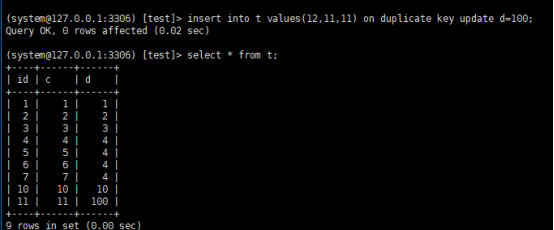40 insert语句的锁
上一篇文章中对mysql自增主键锁做了优化,尽量在申请到自增id后,就释放自增锁。
因此,insert语句是一个很轻量的操作,不过,这个结论对于”普通的insert”才生效,其他特殊的insert语句,在执行过程中需要给其他资源加锁,或者在无法申请到自增id以后就立马释放自增锁。
Insert。。。Select语句
CREATE TABLE `t` ( `id` int(11) NOT NULL AUTO_INCREMENT, `c` int(11) DEFAULT NULL, `d` int(11) DEFAULT NULL, PRIMARY KEY (`id`), UNIQUE KEY `c` (`c`) ) ENGINE=InnoDB; insert into t values(null, 1,1); insert into t values(null, 2,2); insert into t values(null, 3,3); insert into t values(null, 4,4); create table t2 like t
在隔离级别为rr下,binlog_format=statement
|
SESSION A |
SESSION B |
|
Insert into t values(-1,-1,-1); |
Insert into t2(c,d) select c,d from t; |
在实际执行中,如果session b先执行,由于这个语句对表t主键加了(-无穷,1]这个next-key lock,会在语句执行完成后,才允许session a的insert语句执行。
但是如果没有锁的话,就可能出现session b的insert语句先执行,但是后写入binlog的情况,于是在binlog_format=statement的情况下,binlog里面的记录这样的序列:
insert into t values(-1,-1,-1);
insert into t2(c,d) select c,d from t;
这个语句到了备库执行,就会把id=-1这一行也写到表t2中,会出现主备不一致。
Insert循环写入
当然,执行insert...select的时候,对目标表也不是锁全表,而是只锁住需要访问的资源。
下面这一个sql语句
insert into t2(c,d) (select c+1, d from t force index(c) order by c desc limit 1);
这个语句的加锁范围就是表t索引c的(3,4]和(4,supermum]这个next-key lock,以及主键索引上id=4的行。
执行流程,从表t中按照索引c倒序,扫描第一行,拿到这个结果写到表t2中。扫描1行
把这一行插入到表t中
insert into t(c,d) (select c+1, d from t force index(c) order by c desc limit 1);

用到了临时表,执行过程中,需要把表t的内存读出来,写入临时表。
explain结果里rows=1,受到了limit 1的影响。

执行前后增加了6行,innodb_rows_read,因为默认临时表使用memory引擎,所以这6行查的都是表t,进行全部扫描。
执行过程:
--1 创建临时表,字段c和d
--2 按照索引c扫描表t,依次取值,然后回表,读到c和d的值写入临时表,rows_examined=6
--3 由于语义里面有limit 1,所有只取了临时表的第一行,在插入到t中
也就是说,这个语句会导致在表t上做全表扫描,并且会给索引c上的所有间隙加锁共享next-key lock,所以,这个语句执行期间,其他事务不能再这个表上插入数据。
优化方法,这个语句设计的数据量很小,可以考虑使用内存临时表来优化。
create temporary table temp_t(c int,d int) engine=memory; insert into temp_t (select c+1, d from t force index(c) order by c desc limit 1); insert into t select * from temp_t; drop table temp_t;
Insert唯一键冲突
对于有唯一键的表,插入数据时出现唯一性冲突比较常见,
|
SESSION A |
SESSION B |
|
insert into t values (10,10,10); |
|
|
begin; insert into t values (11,10,10); ERROR 1062 (23000): Duplicate entry '10' for key 'c' |
|
|
insert into t values (12,9,9); ERROR 1205 (HY000): Lock wait timeout exceeded; try restarting transaction |
这个例子在rc,rr下执行,session b都会进入block状态。
Session a在执行insert 发生唯一性冲突的时候,在冲突的索引上加了锁,一个next-key lock是由它的右边界的值定义的,session a持有索引c的(5,10]共享next-key lock(读锁)。
官方有一个错误的描述,认为如果冲突的是主键索引,就加记录锁,唯一索引才加next-key lock,但实际上,这两类索引冲突加的都是next-key lock。--已被官方认证。
一个经典的唯一性冲突死锁案例:
|
SESSION A |
SESSION B |
SESSION C |
|
|
begin; insert into t values (11,11,11); |
T1 |
||
|
insert into t values (11,11,11); |
insert into t values (11,11,11); |
T2 |
|
|
rollback; |
ERROR 1213 (40001): Deadlock found when trying to get lock; try restarting transaction |
T3 |
在session a执行rollback回滚的时候,session c几乎同时发现死锁并返回。
------------------------ LATEST DETECTED DEADLOCK ------------------------ 2019-03-27 06:10:07 0x7f3489976700 *** (1) TRANSACTION: TRANSACTION 524813, ACTIVE 4 sec inserting mysql tables in use 1, locked 1 LOCK WAIT 4 lock struct(s), heap size 1136, 2 row lock(s) MySQL thread id 37, OS thread handle 139863640983296, query id 16569 127.0.0.1 system update insert into t values (11,11,11) *** (1) WAITING FOR THIS LOCK TO BE GRANTED: RECORD LOCKS space id 661 page no 3 n bits 80 index PRIMARY of table `test`.`t` trx id 524813 lock_mode X insert intention waiting Record lock, heap no 1 PHYSICAL RECORD: n_fields 1; compact format; info bits 0 0: len 8; hex 73757072656d756d; asc supremum;; *** (2) TRANSACTION: TRANSACTION 524814, ACTIVE 2 sec inserting mysql tables in use 1, locked 1 4 lock struct(s), heap size 1136, 2 row lock(s) MySQL thread id 36, OS thread handle 139863623427840, query id 16570 127.0.0.1 system update insert into t values (11,11,11) *** (2) HOLDS THE LOCK(S): RECORD LOCKS space id 661 page no 3 n bits 80 index PRIMARY of table `test`.`t` trx id 524814 lock mode S Record lock, heap no 1 PHYSICAL RECORD: n_fields 1; compact format; info bits 0 0: len 8; hex 73757072656d756d; asc supremum;; *** (2) WAITING FOR THIS LOCK TO BE GRANTED: RECORD LOCKS space id 661 page no 3 n bits 80 index PRIMARY of table `test`.`t` trx id 524814 lock_mode X insert intention waiting Record lock, heap no 1 PHYSICAL RECORD: n_fields 1; compact format; info bits 0 0: len 8; hex 73757072656d756d; asc supremum;; *** WE ROLL BACK TRANSACTION (2) set global innodb_print_all_deadlocks=1
[mysql@mysqlt1 scripts]$ tail -n 100 /data/mysqldata/3306/log/mysql-error.log TRANSACTION 524813, ACTIVE 4 sec inserting mysql tables in use 1, locked 1 LOCK WAIT 4 lock struct(s), heap size 1136, 2 row lock(s) MySQL thread id 37, OS thread handle 139863640983296, query id 16569 127.0.0.1 system update insert into t values (11,11,11) RECORD LOCKS space id 661 page no 3 n bits 80 index PRIMARY of table `test`.`t` trx id 524813 lock_mode X insert intention waiting Record lock, heap no 1 PHYSICAL RECORD: n_fields 1; compact format; info bits 0 0: len 8; hex 73757072656d756d; asc supremum;; TRANSACTION 524814, ACTIVE 2 sec inserting mysql tables in use 1, locked 1 4 lock struct(s), heap size 1136, 2 row lock(s) MySQL thread id 36, OS thread handle 139863623427840, query id 16570 127.0.0.1 system update insert into t values (11,11,11) RECORD LOCKS space id 661 page no 3 n bits 80 index PRIMARY of table `test`.`t` trx id 524814 lock mode S Record lock, heap no 1 PHYSICAL RECORD: n_fields 1; compact format; info bits 0 0: len 8; hex 73757072656d756d; asc supremum;; RECORD LOCKS space id 661 page no 3 n bits 80 index PRIMARY of table `test`.`t` trx id 524814 lock_mode X insert intention waiting Record lock, heap no 1 PHYSICAL RECORD: n_fields 1; compact format; info bits 0 0: len 8; hex 73757072656d756d; asc supremum;;
死锁产生的逻辑:
--1 在T1时刻,启动session A,并执行insert语句,此时在索引上加了记录锁,这里是唯一索引,next-key 退化为记录锁
--2 在T2时刻,session B要执行相同的insert语句,发现了唯一性冲突,加上读锁;同样的,SESSION C也在索引上加读锁。--间隙锁加锁成功。
--3 在T3时刻,session A回滚,这时候,SESSION B和SESSION C都试图继续执行插入操作,都要加上写锁,两个session都要等待对方的行锁,就出现死锁。--pk,uk都一样的唯一性冲突死锁。
--虽然session在t1时刻没有提交,但是已经作为记录写进入。
Insert into 。。。on duplicate key update
上面的insert改写为
insert into t values(12,11,11) on duplicate key update d=100; 的话,就会给所有c上(11,11]加一个排他的next-key lock(写锁)。这个语句的逻辑是插入一行数据,如果碰到唯一性约束,就执行后面的更新语句。
如果有多个列违反了唯一性约束,就会按照索引的顺序,修改跟第一个索引冲突的行。


--主键id,唯一索引12,1冲突,修改这一行

--主键id=13冲突,修改id=13这一行
主键是先判断的。
需要注意的是,执行这个语句的2 rows affected,实际上更新的只有一行,insert和update都认为成功了,所以update计数加1,insert计数加1。
小结:
上面介绍了几种insert的语句,insert 。。。Select是很常见的在两个表之间拷贝数据的方法,在事务隔离级别为rr下,会给select的表里扫描到的记录和间隙加读锁。
而如果insert和select是同一张表,则可能会造成循环写入,这种情况,可以引入临时表来做优化。
Insert语句如果出现唯一性冲突,会在冲突的唯一键上加共享的next-key lock(S锁),因此,碰到由于唯一性约束的报错后,要尽快提交或回滚事务,避免加锁时间过长。
两个表拷贝数据的常用工具pt-archiver,可以批量删除,插入等。